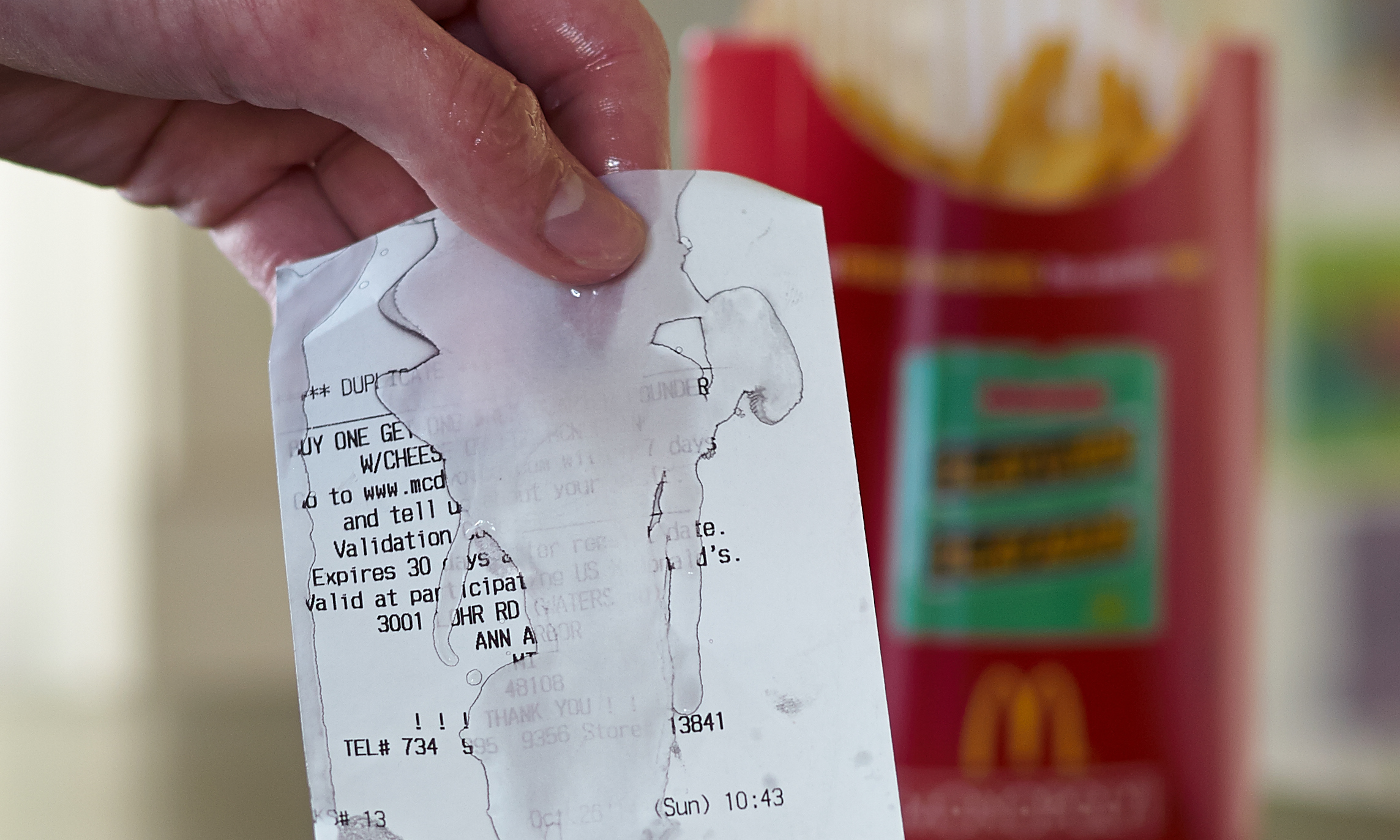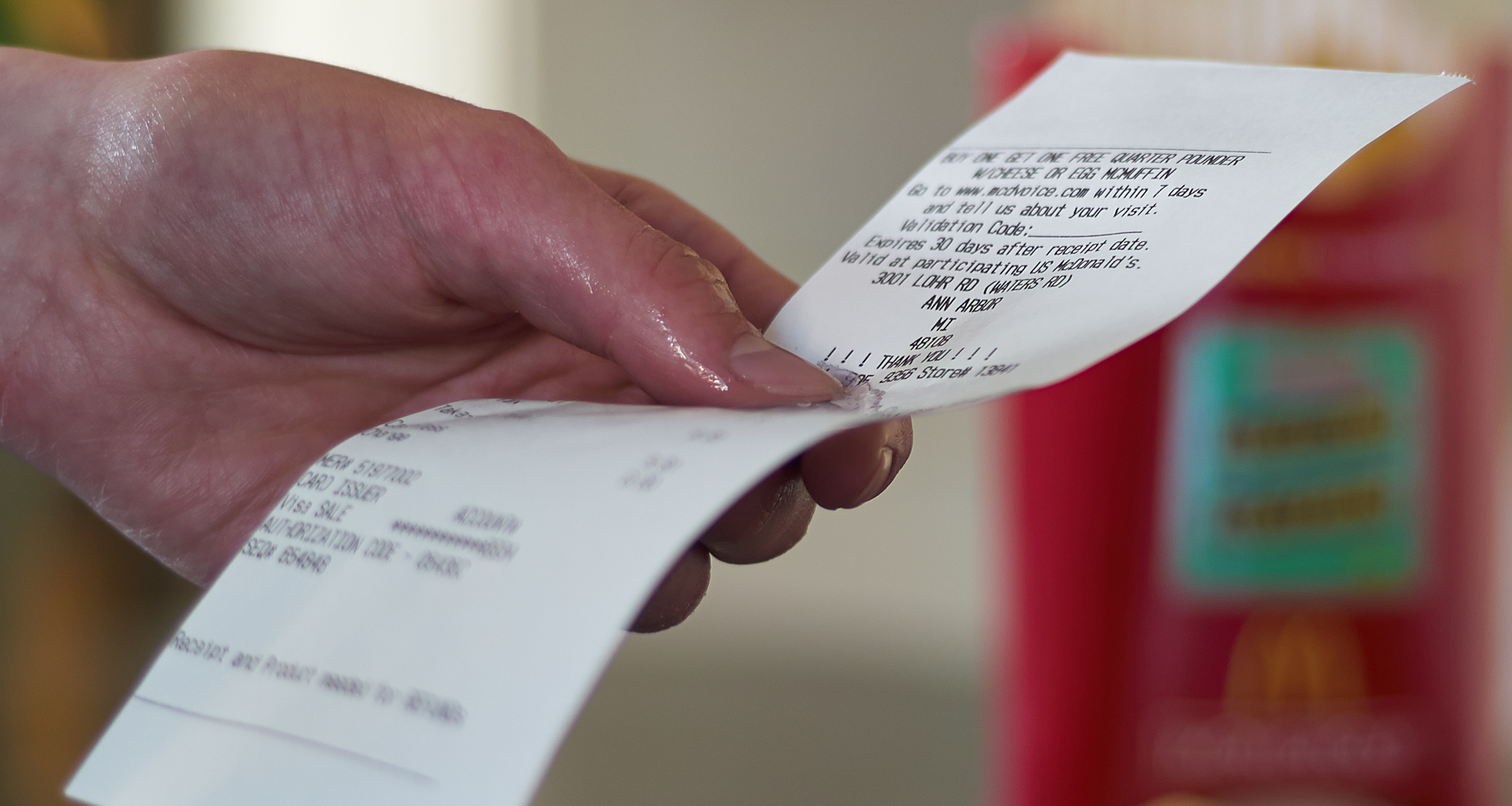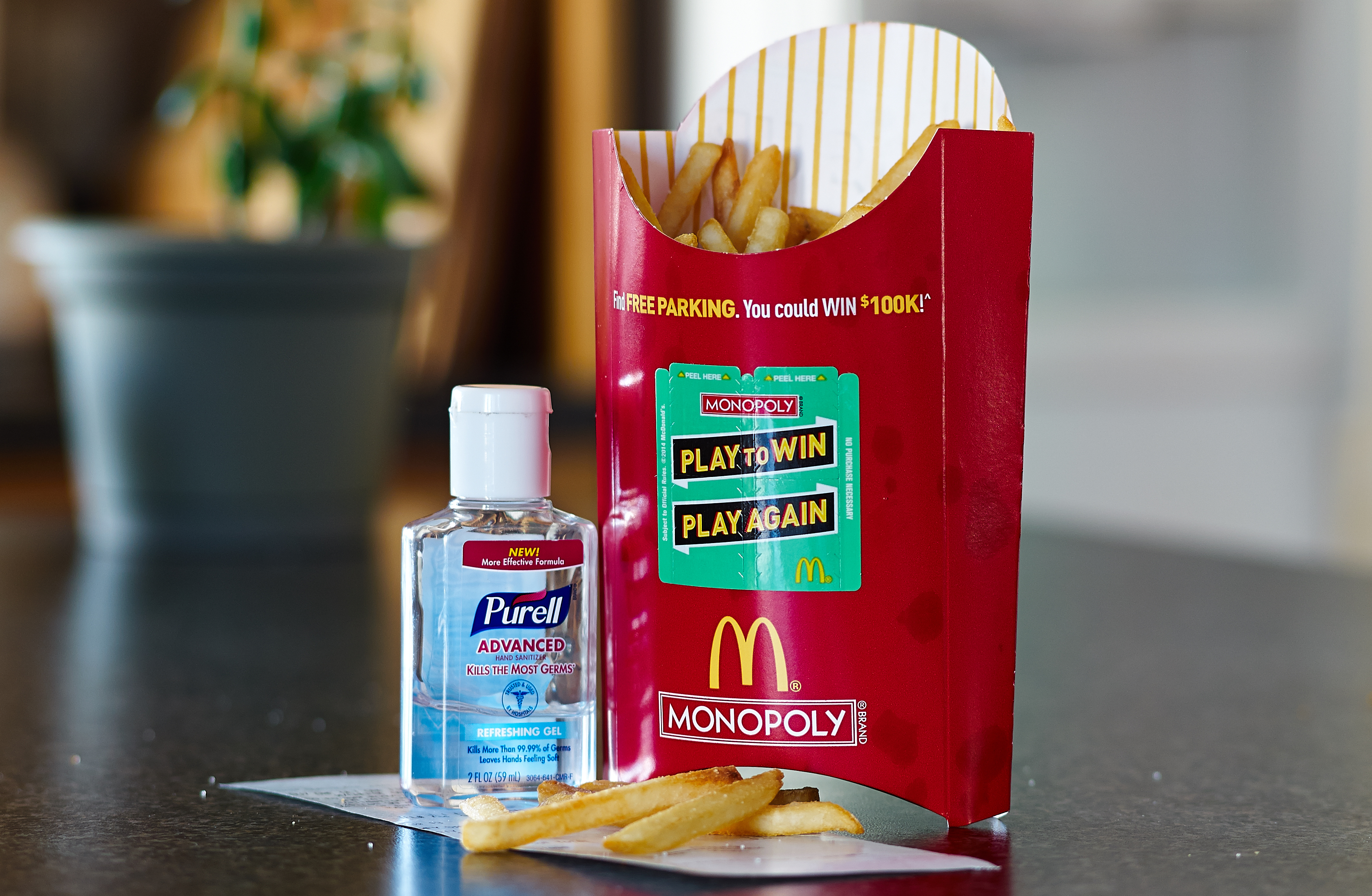I’m a bit of a cash register receipt junkie. I obsessively stuff my wallet with those little slips of thermal paper telling me how much I’ve spent. And it has to be paper – none of this e-receipt nonsense. But an article published last week in the journal PLOS One gave me some pause to rethink this habit.
Bisphenol-A
The paper focused on the substance bisphenol-A, or BPA, a chemical that’s been in the news for a few years now as one that shows hormone-like behavior, and has been associated with a number of health issues. BPA is a component of polycarbonate plastic, and is used as an additive in some epoxy resins and other materials. In recent years, concerns over potential health effects have led to it’s removal or substitution in many cases, especially water bottles and baby bottles, even though the weight of scientific evidence still suggests that, under most circumstances, exposures to the chemical from consumer products are too low to cause concern.
This was reenforced earlier in the year with a long and weighty review by the European Food Safety Agency, or EFSA. Rather than reading the entire 500 pages (riveting as it is), you can catch the highlights in under five minutes in this Risk Bites video:
The EFSA review reiterated the findings of a number of other expert assessments and concluded that, while BPA has the potential to cause harm in the body at high levels, most exposures are so low that the risks are negligible based on current understanding.
However, the vast majority of studies carried out so far – and the focus of the EFSA report – assume that ingesting BPA from contaminated food is the most relevant source of exposure. Ingested BPA isn’t readily absorbed from your gut, and when it is, the substance is rapidly converted, or metabolized, into a less harmful form, and got rid of in healthy adults.
BPA in cash register receipts
There is another way that BPA can potentially get into your body though, and that’s through your skin. This is the route that the team based at the University of Missouri were particularly interested in. And in particular, whether BPA in those ubiquitous cash register receipts could present an issue.
BPA is used as a developer for heat-sensitive ink in many cash register receipts that use thermal paper. It’s applied as a surface coating, and so in principle can be transferred from the receipt to your hands during handling. From there, there’s the possibility of it passing straight through your skin and into your body, or transferring to food that you’re holding, and from there into your gut.
Can BPA get into your body through your skin?
Previous research has hinted that this might be a viable exposure route. It’s an interesting one as, unlike polycarbonate bottles where most of the BPA is locked up in the plastic, the BPA used in thermal paper is relatively available. Research so far has indicated that handling cash register receipts probably doesn’t lead to high exposures under normal conditions. However, the Missouri team wondered whether there were circumstances that might change this – using hand sanitizers for instance that are potentially able to dissolve the BPA from the receipt, and enhance absorption through the skin.
To test this, they first measured how much BPA was present in a number of cash register receipts. Taking a bunch of receipts from local retailers, they found an average of 20 mg of BPA per receipt in those that used the substance – in other words, 2% the weight of these receipts was BPA.
Next, they set up an experiment to see how much of this BPA could transfer from a receipt to the surface of someone’s hand. They tested the normal case of someone with dry hands handling a receipt for different lengths of time (up to 6 minutes). They also tested what happens when someone slathers their hands with Purell and holds a receipt, without first allowing the hand sanitizer to dry.
In the absence of Purell, a small amount of BPA was left on the hands of volunteers after handling receipts – the longer the hold-time, the more was left. After 6 minutes, an average of 7 µg of BPA ended up on a person’s hand – around 0.08% of the BPA on the receipt. Combining a Purell-coated hand with a receipt led to a maximum of 600 µg of BPA being transferred after one minute (after this, the measured amount decreased, possibly because it was already working its way through the skin and into the body). In other words, around 7% of the BPA on the receipt ended up on the hand after one minute, if that hand was coated in Purell and was still wet.
The next step was to measure how much of that BPA was able to pass through the skin and into the bloodstream. As volunteers were holding a BPA-coated receipt, blood was taken from their arm and analyzed for the chemical. Analysis looked at the quantity of free BPA in the blood (the potentially harmful stuff – referred to as “unconjugated” BPA or uBPA), and the quantity of “conjugated” BPA (BPA that has been effectively neutralized by the body).
The receipt was held for four minutes with the BPA-coated side in contact with the hand, and blood samples were taken for 90 minutes. The researchers also got their volunteers to eat 10 french fries from their Purell and BPA-coated hands, to estimate how much of the substance could be re-transferred to food, and from there to the mouth.
The importance of Hand Sanitizer
The study discovered that measurable quantities of unconjugated BPA enter the bloodstream within minutes of holding a BPA-containing receipt for 4 minutes in a Purell-coated hand. The peak blood concentrations measured were 5.7 nanograms of unconjugated BPA per milliliter of blood for males, and 10.2 nanograms per milliliter of blood for females. In other words, if you took a blood sample from one the arm of the female volunteers when the peak concentration of BPA was reached, around ten billionths of that sample would be BPA.
For those volunteers who didn’t use the Purell, there was no measurable increase in BPA in their blood.
Looking at the results from the people who also handled and ate the french fries, it appeared that most of the BPA found in blood samples was from the skin, and not from transferred BPA entering the gut. However, there was some speculation that BPA on the fries could have passed into the bloodstream through the inside of the mouth.
Like most research studies, this one provides another piece to the the puzzle of whether exposure to BPA is a significant health issue. But it doesn’t solve the puzzle. It does show that the combination of hand sanitizer and BPA-containing cash register receipts can lead to elevated levels of unconjugated BPA in the blood stream. This raises important questions, as the exposure route hasn’t previously featured greatly in assessments of BPA health risk. It also shows that when handling receipts with clean, dry hands, there isn’t likely to be significant transfer of the BPA from receipts to the blood.
Data interpretation isn’t straight forward
Interpreting the data any further than this though is not straight forward. The exposure scenarios using the Purell were not that realistic – handling receipts with hands still coated in wet, slimy Purell isn’t likely to be routine for most people. neither is holding receipts in Purell-coated hands, with the printed side palm-down, for up to four minutes.
The measured blood levels are also hard to interpret as they are peak levels from one-off events, and while measurable, they are small. To quantify the risks associated with these levels, more information would be needed on how often such events occur over the space of a day. In other words, what is important is not a one-off peak, but the dose received over time, and whether this exceeds levels that cause concern.
One aspect of the study that is certainly worth further investigation is the relatively high levels of unconjugated BPA compared to conjugated BPA. These are substantially higher than those observed when BPA is ingested, and are possibly due to BPA passing through the skin and entering the bloodstream before passing through the liver, where it is efficiently metabolized. The authors suggested that this may increase the risk to sensitive organs and systems within the body – but without further research, this remains speculative.
Don’t dump your receipts just yet
The bottom line is that I’m not going to change my cash register receipt habits. The research extends the current state of the science, but not enough at this stage to demonstrate a clear and urgent issue with common cash register receipt practices. That said, it does indicate that further research is needed – especially where vulnerable individuals are concerned.
It also suggests that smothering your hands with Purell and clutching your receipts for several minutes probably isn’t advisable. Especially if you’re just about to tuck into a plate of french fries.
As an aside, in shooting the photos here, I was interested to see how soluble the ink (and presumably as a result the BPA coating) was in the hand sanitizer – this stuff washes off like nobody’s business!




If you spend time in fast food joints, as the authors of this study did, you can regularly observe exactly the scenario they tested: holding a receipt after using a skin sanitizer (dispensers are often by the cash register). I see this regularly too. And more. People will put the receipt in their mouth when they pick up their food to carry a tray to a table. Or they will hold an airplane ticket with their lips (airplane tickets are also often thermal paper) as they are going through security. Massive doses.
You are correct to focus on the relatively high ratio of unconjugated to conjugated BPA in these results. The FDA maintains that is impossible because of first pass metabolism by the liver. And on that basis, the FDA throws out studies with similar ratios, asserting they must be contaminated samples (which then leaves them with only studies that find low amounts, allowing them to conclude that people are not exposed to high enough levels to matter— circular logic at its best). But these data show ratios like that occur in the real world, showing that FDA’s assumption they are impossible is quite simply wrong.
Moreover, the assumption of largely first-pass metabolism assumes there is no sublingual absorption (via soft oral mucosa in the mouth). The Gayrard reference (#19) in this paper shows that sublingual absorption (like when you are chewing on something, quite similar to what happens when a heart attack victim takes nitroglycerin under the tongue) is an important pathway of absorption AND that it leads to very high ratios of unconjugated:conjugated BPA.
The Gaylord paper in combination with these results prove that the FDA’s basic assumptions that allow it to conclude BPA is safe are false. And on top of that, read this new scientific paper, which further explores the shoddiness of FDA’s science on this issue. http://bit.ly/1w5pPPM (vom Saal and Welshons 2014. Evidence that bisphenol A (BPA) can be accurately measured without contamination in human serum and urine and that BPA causes numerous hazards from multiple routes of exposure. Journal of Molecular and Cellular Endocrinology 10.1016/j.mce.2014.09.028
The ‘Gaylord’ reference in the final paragraph was caused by a spell checker. It should be Gayrard.
Thanks Pete Myers. Very helpful and informative information!
And what about those that handle receipts all day long? Every cashier I know has a bottle of hand sanitizer and/or hand lotion at their station and most use it often. What are their risks? Note that this is 2014 and when I googled the subject I found definative studies and articles on this dated 2010!